

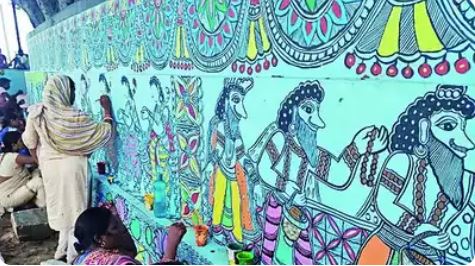
About Madhubani Paintings
Madhubani paintings are a traditional art form of the Mithila region in India. They have been practiced since the Ramayana and Mahabharata, both written and oral epics that tell stories about Lord Rama, Krishna, and Arjuna respectively.
Themes of Madhubani Art
Madhubani paintings are often based on mythology, folklore, and religious beliefs. Some of them depict social issues in society while others depict daily life; they also show nature as part of their theme. Themes are different for each artist, but all have one thing in common – they are colorful, vibrant, and full of imagination!
Intricate Designs- Understanding the Patterns of Madhubani Paintings
The paintings are characterized by intricate and repetitive patterns created using fine lines and dots. These patterns are meticulously drawn using a bamboo stick or a nib made from cotton wrapped around a twig. The precise and intricate arrangement of these patterns showcases the artist’s skill and attention to detail.
- Circles -Circles represent the sun, the moon, or the cyclical nature of life. They symbolize harmony, unity, and completeness in the composition. They can be seen as halos around deities or used to depict floral motifs.
- Triangles -Triangles represent mountains, trees, or sacred feminine energy and are often used to form the bodies of animals, adding a dynamic and angular aspect to the artwork.
- Dots or Bindis -Dots are extensively used to fill spaces and create intricate patterns in Madhubani paintings. They are made with the end of a twig or brush and are used to form elaborate designs, highlight details, and add texture to the artwork.
- Grids and Borders -Geometric grids and borders are often employed to define the composition and provide a structured framework for the painting. These grids act as guides for maintaining symmetry, balance, and proportion within the artwork.
Madhubani Symbols: Unveiling Cultural Narratives in Bihar’s Art
In Madhubani art, each symbol weaves a narrative reflecting the region’s cultural heritage and spirituality. The combination of these symbols creates a visually captivating and culturally profound expression of art, making Madhubani paintings a cherished part of Bihar’s artistic legacy.
- Peacock – Symbolizes beauty, grace, and divinity. Associated with the goddess Saraswati, representing wisdom.
- Lotus – Represents purity, enlightenment & divine beauty. Has deep cultural significance in Hinduism.
- Fish – Symbol of fertility and abundance. Portrayed in pairs, signifying prosperity and marital bliss.
- Elephant – Represents strength, royalty, good fortune. Often adorned with intricate designs for auspiciousness.
- Sun and Moon – Symbolize cosmic harmony and the cyclical nature of life. Contribute to the paintings with celestial energy.
- Tree of Life – Depicts interconnectedness and the cycle of life. Adorned with birds and animals, symbolizing fertility.
- Snakes – Represents both positive and negative forces. Symbolizes protection, transformation, and potential danger.
- Mandalas – Intricate geometric patterns in concentric circles. Symbolizes the universe, spiritual energy, and balance.
- Circles and Dots- Fundamental elements representing cosmic elements. Add symmetry and aesthetic appeal to Madhubani art.
- Parrots – Symbolize love and fidelity. Portrayed in pairs, emphasizing enduring bonds and harmonious love.
Unraveling Madhubani Painting Styles: Unveiling Cultural Narratives in Bihar’s Art
There are five main types or styles of Madhubani paintings namely Bharni, Kachni, Tantrik, Godna, and Kohbar—each carry their essence, showcasing distinct styles, motifs, and themes. The variety in these styles reflects the multiplicity of stories, traditions, and beliefs woven into the richness and intricacy of Madhubani art. Let’s explore them briefly below.
1.Bharni – The Art of Filling
This is one of the most famous styles of Madhubani painting. The word “Bharni” in Hindi language means “to fill” or simply “filling”. The Bharni style of Madhubani painting is characterized for its portrayal of Hindu deities from the Hindu Mythology in a very colorful form The Bharni style of painting lavishly deals with a rich variety of colours. Mostly the enclosed areas are filled with vibrant colors like blue, yellow, pink, green, orange colors, etc. and the subject is outlined in black.
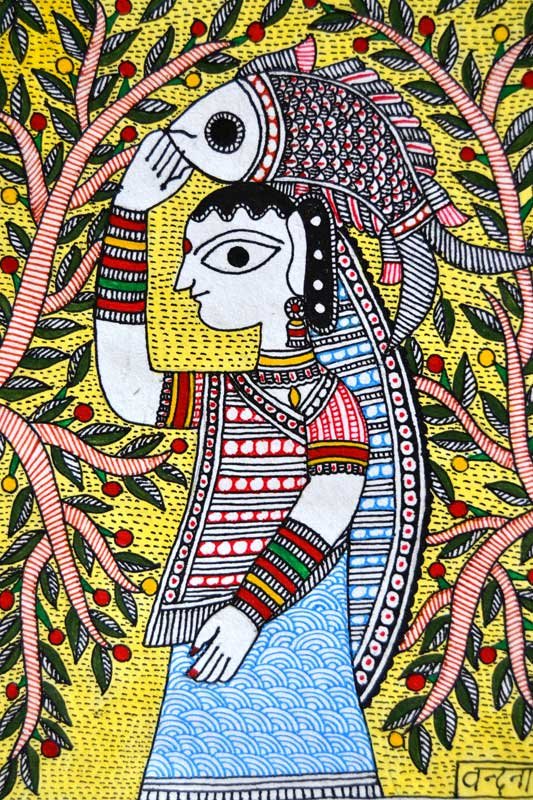
2. Kachni
This style belongs to the Kayastha community of India. The Kachni style can be distinguished from other styles by way of the usage of monochrome, two tone colors in the depiction of nature, and line work. Mainly black and vermilion (brilliant red) colors are used here. The thickness of the lines depends on the design. This style of painting attracts the audience since they highlight the peculiar features of natural aspects with a limited color range. The distinction in form is mainly seen in the linework of the paintings.

3.Godna
This form of painting emerged from gypsy women who tattooed their body parts with auspicious symbols since they could not afford jewelry. Godna means tattoo in Hindi. The images are drawn in black, but some are also filled with colors. Some Godna style artists use cow dung washed handmade paper to make paintings. In the Godna style, repeated images are arranged in parallel lines, concentric circles, or rectangles to form various patterns.
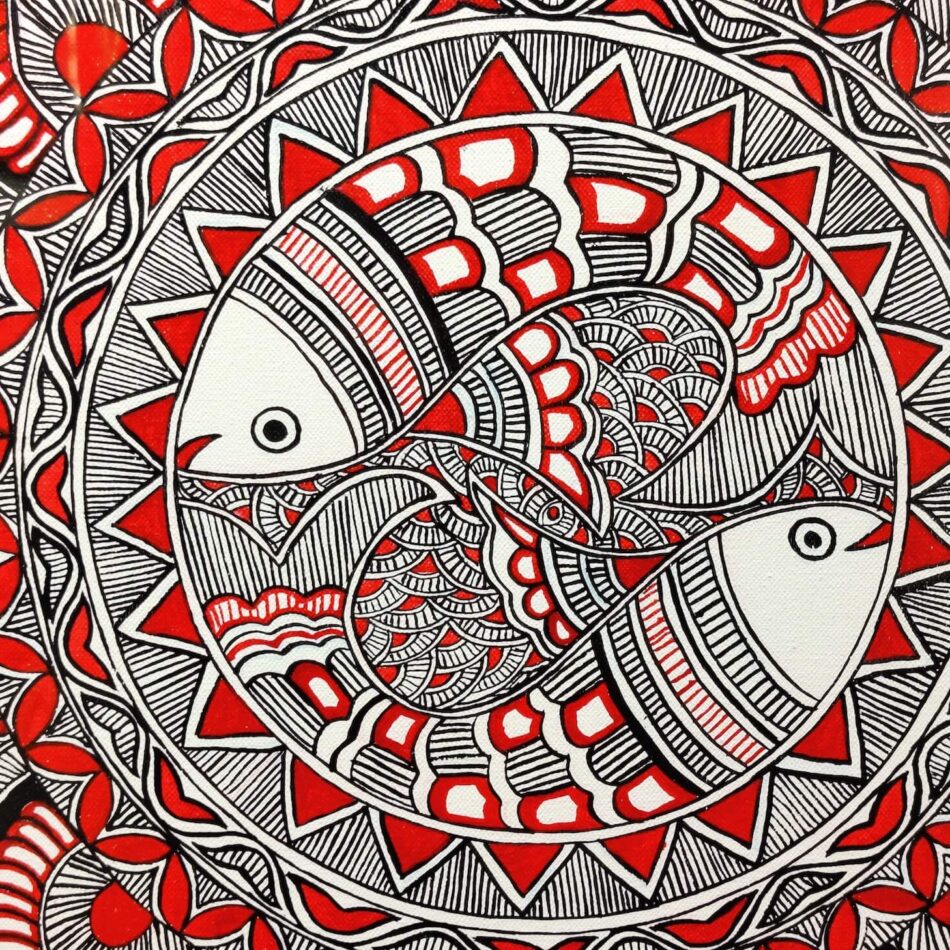
4.Kohbar
Madhubani encompasses the ‘Kohbar’ style, traditionally used to decorate wedding chambers and is one of the most popular forms of Madhubani art. Like Godna this style also depicts the versatility of Madhubani art, transcending canvas to adorn various surfaces. Kohbar characterizes depiction of wedding ceremonies followed in the Hindu religion.
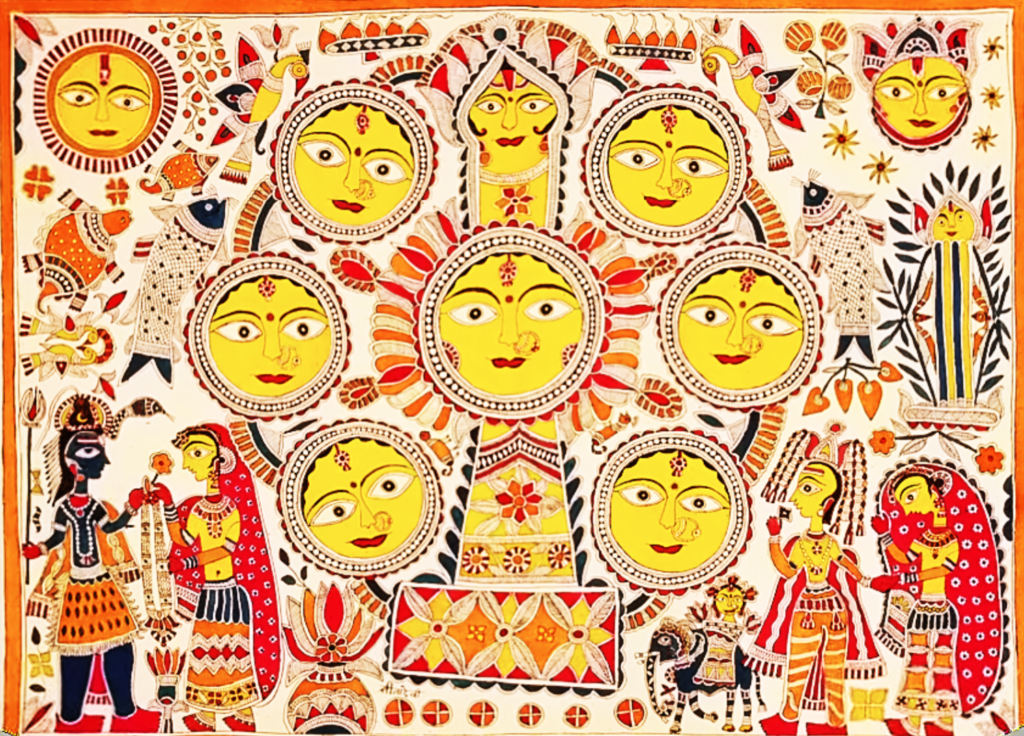
5.Tantrik
This painting is distinguished from other styles of Madhubani painting. It solely depicts religious texts and characters related to them. The Tantrik style of painting of Mithila or Madhubani art is a very distinct style of painting. This style represents the traditional and religious texts in a very precise manner. Tantra is an original text describing the Hindu religion and its aspects. Therefore, most of the paintings of the Tantrik style have the influence of Tantra in their painting patterns.
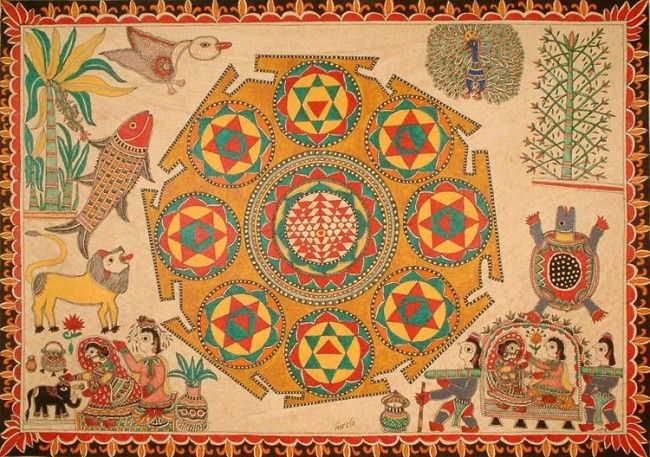
Craftcrest India celebrates this timeless art form by offering a curated collection that showcases the beauty and craftsmanship of Madhubani. Immerse yourself in the world of Madhubani magic, where tradition meets modernity, and every stroke tells a story on Craftcrest India.
Shop Madhubani Paintings in its various forms at https://craftcrestindia.com/product-category/handicraft/

